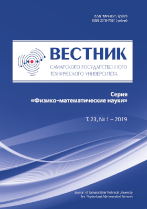|
Differential Equations and Mathematical Physics
The vortex filament dynamics: New viewpoint on the problems of energy and effective mass
S. V. Talalov
Togliatti State University,
Togliatti, 445020, Russian Federation.
(published under the terms of the Creative Commons Attribution 4.0 International License)
Abstract:
The paper is devoted to the dynamics of a zero thickness infinite vortex filament in the local induction approximation. The filament is asymptotically considered as a straight line defined by the certain vector b3∈E3.
We also investigate the possibility of interpretation of such object as a planar “quaziparticle”. The configuration space for some “collective coordinates” for such object is the plane E2⊥b3.
The “quaziparticle” has a certain number of the internal degrees of the freedom. The Hamiltonian description of the filament is constructed in terms of the variables allowing the natural classification into “external” and “internal” groups.
The external variables (coordinates and momenta of a planar structureless particle) and the internal ones (the variables for the continuous Heisenberg spin chain) are entangled by the constraints. Because of these constraints, the constructed theory is non-trivial. The space symmetry group of the system was constructed by two stages: the contraction SO(3)→E(2) and the subsequent extension E(2)×T→˜G2. The group E(2) is the group of the plane motion for the plane E2⊥b3, symbol T denotes the group of time translations and the group ˜G2 is the central extended Galilei group for the plane mentioned above.
The appearance of the Galilei group makes it possible to introduce the invariant Cazimir functions for the Lee algebras for this group and to formulate the new approach for the problem of the energy of the infinite vortex filament with zero thickness. The formula for the tensor of the inverse effective mass of the constructed system is also being deduced. It is demonstrated that the suggested theory can be interpreted as a model of the planar vortex particle having an infinite number of internal degrees of freedom.
Keywords:
vortex filament, constrained hamiltonian systems, effective mass.
Received: October 10, 2018
Revised: February 4, 2019
Accepted: March 4, 2019
First online: March 12, 2019
Citation:
S. V. Talalov, “The vortex filament dynamics: New viewpoint on the problems of energy and effective mass”, Vestn. Samar. Gos. Tekhn. Univ., Ser. Fiz.-Mat. Nauki [J. Samara State Tech. Univ., Ser. Phys. Math. Sci.], 23:1 (2019), 37–48
Linking options:
https://www.mathnet.ru/eng/vsgtu1652 https://www.mathnet.ru/eng/vsgtu/v223/i1/p37
|

| Statistics & downloads: |
| Abstract page: | 436 | | Full-text PDF : | 308 | | References: | 69 |
|




 Contact us:
Contact us: Terms of Use
Terms of Use
 Registration to the website
Registration to the website Logotypes
Logotypes










 Citation in format
Citation in format 